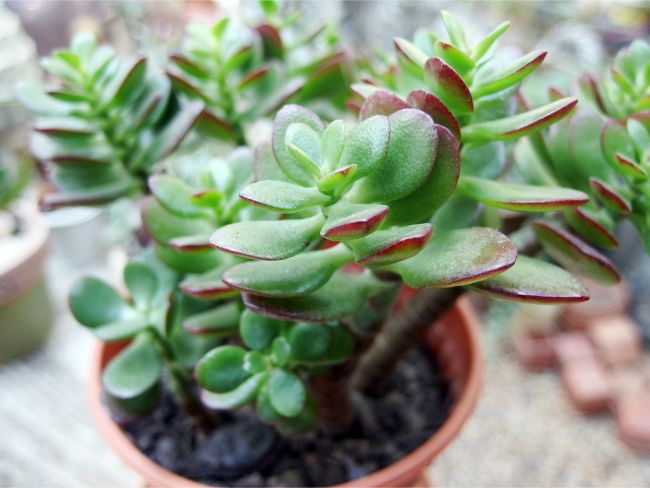Bring a little luck, or at least a little beauty, into your home with the gorgeous jade plant, Crassula Ovata. Providing good jade plant care is really quite easy, making them a great choice of houseplant for beginners and experienced gardeners alike.
Jade Plant Care Summary: Plant your jade plant in well draining succulent mix, provide a mix of direct and bright indirect light, and water thoroughly once the potting mix is almost completely dry. Provide temperatures of 65-86°F (18-30°C) and fertilize every 1-2 months during the growing season.
Read on to learn all you need to know about jade plant care. This guide covers all aspects of care, as well as how to prevent and fix the common problems, to keep your jade plant thriving.
Jade Plant Overview
Crassula Ovata is also known as the jade plant, lucky plant, friendship plant, and money plant. It is thought to bring good luck and good fortune to those who own one. This plant is immensely popular as a houseplant, but in some grow zones, this plant can even be used as a beautiful landscape plant.
Characteristics Of Jade Plants
The jade plant is a unique succulent that looks like a small tree. Its rounded leaves are a deep, glossy green, with hues of red or blue depending on the variety and the leaves branch out from woody stems. Jade plants can grow white to pink blooms, although they rarely bloom indoors.
This shrubby little plant is easy to propagate and requires very little maintenance. It originated in South Africa but is also popular in Asia as a symbol of luck and fortune. It can easily grow three to six feet high indoors but can also be easily pruned to fit into any size house.
Jade Plant Care Requirements (Crassula ovata)
- Scientific Name: Crassula ovata
- Common Name: Jade plant, money plant, lucky plant.
- Origin: South Africa and Mozambique
- Light Requirements: Mix of direct and bright, indirect light. 4-6 hours of direct sunlight is ideal.
- Watering: Water thoroughly once the potting mix is dry.
- Soil: Equal parts potting mix and coarse sand or perlite. Cactus or succulent mix is also great.
- Temperature: Daytime temperatures of 65-86°F (18-30°C) are perfect.
- Fertilizer: Balanced, water-soluble fertilizer applied every 1-2 months through the growing season. I use this one.
- Humidity: Tolerant of a wide range of humidity.
- Pruning: Prune to maintain size and shape.
- Propagation: Stem, leaf and seed propagation is fairly simple.
- Re-Potting: Prefer being root bound.
- Diseases and Pests: Mealybugs and spider mites can be an issue. Black soft spot, powdery mildew and black ring disease can occur.
- Toxicity: Generally non-toxic to humans. Toxic to cats, dogs and some other animals.
- Where To Buy: Buy a Jade Plant online at Etsy (I buy most of my houseplants from Etsy).
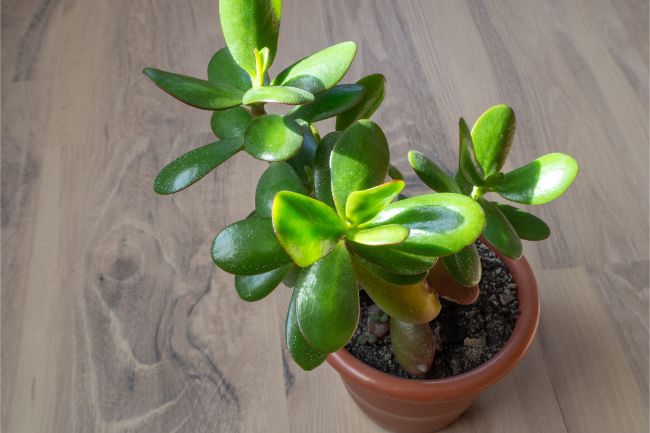
Jade Plant Light Requirements
Jade plants that are grown outdoors seem to do best with around four to six hours of direct sunlight, with a little shade from the intense rays of the afternoon sun. If you are growing your jade plant indoors as a houseplant, it will do best in a southern window with four or more hours of direct sunlight.
Jade plants can tolerate lower light levels, though. Variegated varieties of jade plants can grow very successfully in much less light, especially if your room has bright indirect light.
How To Water A Jade Plant
Jade plants, like other succulents, need to be watered sparingly. Underwatering is preferred to over-watering for good jade plant care. To water your jade plant, give it a long drenching soak. Water it until the water begins to run out of the drain holes in the bottom of your pot. Then allow all of the water to drain out.
If the plant sits in water for too long, it will be very susceptible to root rot, which can kill your plant. Do not water your plant again until the soil has almost completely dried out.
If you do not give your jade plant enough water, you will begin to see shriveling leaves, dropping leaves, or leaf spots. In the summer, when the plant is actively growing, it will need to be watered more often.
In the winter, when growing has slowed and the plant is resting, the plant will need much less water. Water it just enough to keep the leaves from shriveling throughout the winter.
How Often To Water A Jade Plant
You will probably need to water your jade plant somewhere between every seven to fourteen days. However, don’t just stick to a schedule, make sure you keep your eye on the plant and its pot. There are lots of ways to tell when your jade plant needs watered. I’ve covered them all in a helpful article which explains exactly how to tell when to water your plants.
I use a combination of feeling the soil with my fingers, both from the top and through the drainage holes at the bottom. I also look at the foliage, feel the weight of the pot and consider the climate and rate of growth before deciding when to water my jade plants.
If your plant is planted outside in the ground, it will probably need watered less frequently than jade plants that have been planted in a container. Containers will dry out and lose moisture much faster than the plants in the ground. Also, when your jade plant is established with a deep root system, it will probably need watered much less often.
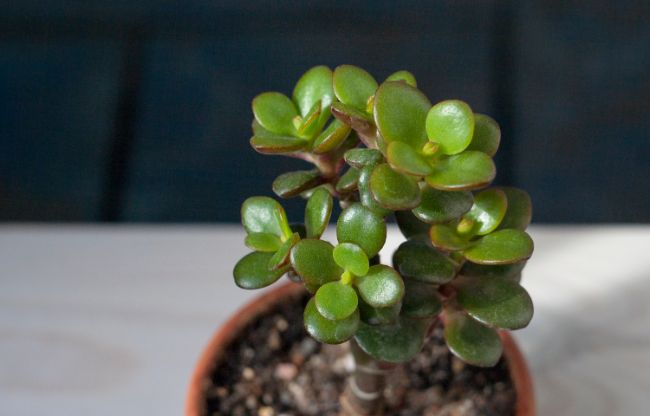
Jade Plant Soil Requirements
You can easily grow jade plants in a commercial succulent or cactus soil. These mixes are readily available and are conveniently packaged in smaller bags, just right for your plants.
If you don’t want to purchase pre-mixed soil, you can create your own. Just mix 3 parts coarse sand with one part peat moss and one part potting soil for a rich but well-draining potting soil mix. You could also use equal parts potting mix and perlite for similar results.
Temperature Range For Jade Plants
Jade plants are tropical house plants. They prefer to grow in daytime temperatures between 65-86°F (18-30°C) and night temperatures that are between 50-55°F (10-13°C).
If your jade plant gets too cold, it could become limp, especially if it is exposed to freezing temperatures. If this happens, wait and see if it perks back up. If any leaves or branches turn black or don’t revive, prune them off.
Like other succulents, your jade plant can get sunburn if it gets too much direct sun. If you grow your jade plant indoors and then move it outside for the summer, you’ll want to make sure that you keep your plant out of direct afternoon sun.
Take the time to acclimate your plant to the outdoors slowly. If your plant does get white patches or burns, you won’t be able to undo the damage to the burned leaves. However, jade plants are hardy and may grow new leaves to replace the leaves that were burned.
How To Fertilize A Jade Plant
Jade plants will benefit from fertilizer when they are actively growing. A little goes a long way, so fertilizing every 1-2 months is plenty. You can easily find commercial liquid fertilizer intended for succulents or cacti. Dilute it to half strength and apply it to your jade plants during its active growing season in the spring and summer.
If you can’t find a commercial succulent fertilizer, a balanced water-soluble fertilizer will generally be fine. Salt build-up in the soil can cause problems over time, so I usually flush the soil with plenty of water every few months to prevent this from happening.
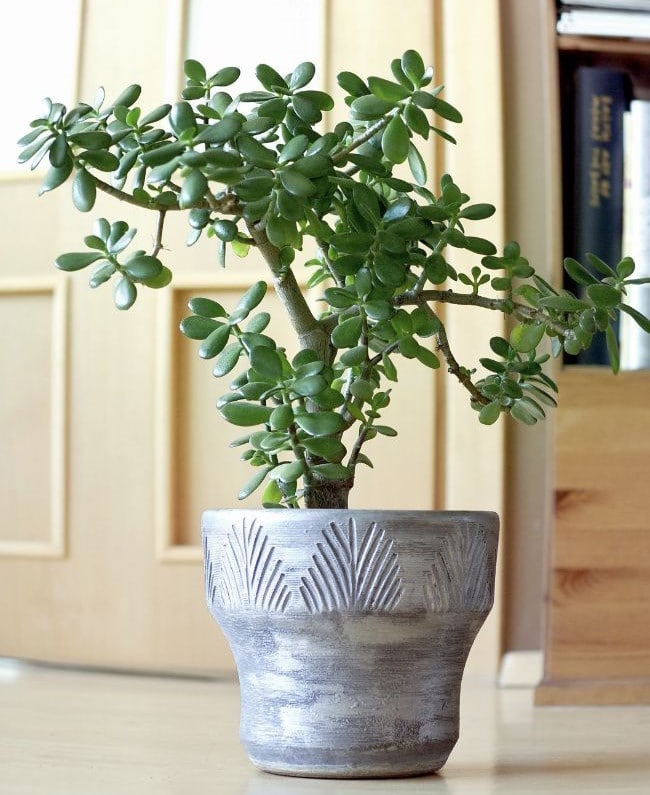
Jade Plant Humidity Needs
Healthy humidity in the home runs about 40% to 50%, which is just perfect for the desert-growing jade plant. Jade plants will generally tolerate a wide range of humidity levels, but try to avoid excessively high levels.
If your home is very humid, keep your jade plant closer to heaters and air conditioners where the air is a little bit dryer. Keep your jade plant in a room that gets good circulation, as well.
Will My Jade Plant Flower?
Jade plants grow small, pale pink or white blooms that are shaped like stars. Indoor jade plants rarely bloom, but you may be able to force blooms if you can get the lighting conditions just right.
Jade plants growing outside in North America are triggered to bloom by the shortened daylight hours in the fall and winter, producing blooms in winter and spring. If you want to get your indoor jade plant to bloom, you’ll need to imitate these conditions.
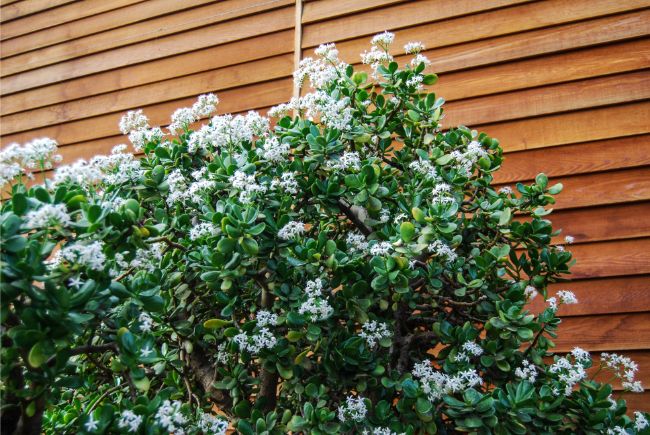
How To Prune A Jade Plant
Your jade plant does not necessarily have to be pruned. However, jade plants can grow pretty large, so you may want to prune your plant to keep the size under control. You may also want to prune away any dead branches or dying leaves as part of your jade plant care routine.
If your jade plant is growing a bit lopsided, you could also prune it for aesthetic reasons. Jade plants are pretty hardy and can withstand a good pruning if you choose to do so.
The best time to prune is early in the spring when new growth begins. Take a good look at the size and shape of your plant. Is it growing more on one side than the other? Do you want it to look more bushy or more tree-like?
Use sharp shears to cut back any overgrowth. If the stem is overgrown, cut it close to the branch or shoot. If there are unhealthy branches or branches you don’t want, cut them flush against the branch, but don’t cut into the branch.
If you want to control the height, you can remove up to one third of the plant. To help maintain the size of your jade plant, you can also remove the plant from its pot and trim off as much as 1/3 of the root ball and then replant the jade into fresh soil.
How To Propagate A Jade Plant
You can propagate your jade plants very easily from branches, leaves, and seeds. The method for propagation of jade is similar to any other succulent.
Stem Or Branch Propagation
If you want to use a branch to propagate your jade plant, select one that is healthy and approximately three to four inches long. Cut off the branch with a sharp, clean knife and allow it to dry out until a callous develops over the wound. This takes a week or two and will prevent the cutting from becoming diseased once it is planted.
The cutting can be dipped into rooting powder to help promote root growth and to further prevent disease. Plant the cutting into a mix of half potting soil and half perlite. Water sparingly until it has rooted, then treat it as you would any mature jade plant.
Leaf Propagation
Jade plants can also be propagated from a single leaf, but this method will take longer than using a branch for propagation. Carefully remove a healthy leaf from your jade plant. All you need to do is lay the leaf on top of your potting mixture.
For good drainage, use a 50/50 mix of potting soil to perlite. Water the soil sparingly until the leaf begins to grow roots but try not to leave water sitting on the leaf. Within two months, and after roots have begun to grow, the leaf will begin to put out tiny plants where it touches the soil. You can treat the tiny plantlets as you would any jade plant once they reach a few inches tall.
Seed Propagation
If you would rather, you can also grow your jade plants from seed. You need a small pot with good drainage holes. Fill your pot with cactus and succulent soil and then plant a couple seeds right in the middle. You’ll need to water the seeds at least once a week, keeping the soil moist but not soggy.
You can create a small greenhouse over your pot by placing a clear plastic bag or the top half of a plastic milk jug over it to help keep the moisture in. You may need to cut a few small holes in your bag or jug for circulation.
Once your seedlings have grown several leaves you can finally plant them in their own pots. Be gentle with the tiny plants as you remove them from the pot. The new pot should have good drainage holes and a mixture of potting mix and perlite, or some kind of cactus and succulent potting soil.
Make a small hole in the middle of the pot, just big enough for the roots on one seedling. Fill around it with soil. Water only when the soil dries out and fertilize as needed.
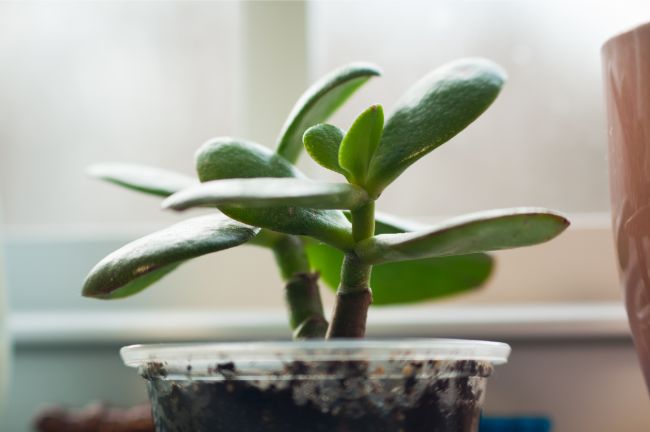
Tips For Planting And Good Jade Plant Care
- Jade plants can easily become top-heavy. Plant them in a heavy pot to keep them from toppling over.
- You can gently wipe off the leaves of your jade plant with a damp cloth if they become dusty.
- If your plant starts to look tall and leggy, you can pinch off the new growth. This will help your plant grow with a fuller, more compact shape.
- Remove any mealybugs or spidermites with a cotton swab dipped into rubbing alcohol.
- Don’t overwater your jade plant.
Re-Potting
You won’t need to repot your jade plant often. They are happy being rootbound, and this will help them stay at a more manageable size. If you want to encourage your jade plant to grow larger, repot it every couple of years.
The best time to repot your plant is in the early spring before new grew begins to show. You’ll know your plant is ready to be repotted if you can pull the plant out of its pot and the roots stick together in a ball shape. If the roots are more loose, then you can keep it in the same pot.
If you do need to repot your jade plant, you’ll want to do so when the soil is dry. Carefully slide the plant out of its pot. Brush away the old soil and remove any roots that have become soft, rotted, or have died. Place the plant in a new pot and adjust it so that it is growing straight. Fill in around the roots with soil. Wait a few days before resuming your watering schedule.
Jade Plant Varieties
Although the standard Crassula ovata is by far the most popular variety you will see, there are actually many interesting varieties of jade plants. Here are a few interesting types you might like to consider;
Crassula ovata
This is the most common type of jade plant. Ever popular due to the attractive, deep green leaves, with edges that can turn red in bright light or when the plant is a little stressed.
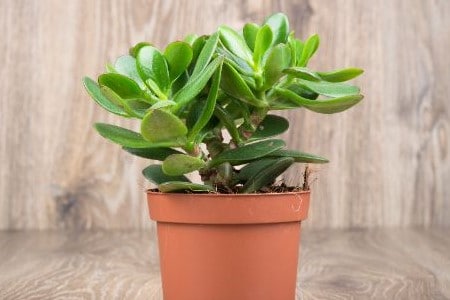
Crassula ovata ‘Hummel’s Sunset’
This fascinating Crassula ovata cultivar was produced in California in the 1960s. It has variable photoreactive leaves that are a mix of red, yellow, orange and green, depending on the lighting provided.
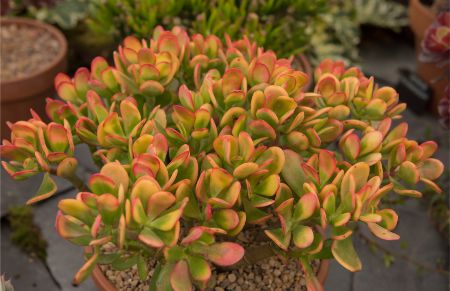
Crassula ovata ‘Tricolor’.
Crassula ovata ‘Tricolor’ has beautiful multihued leaves marbled with green and white. Bright sun encourages the edges to turn a wonderfully contrasting shade of red. Has the same growing habit as regular Jade.
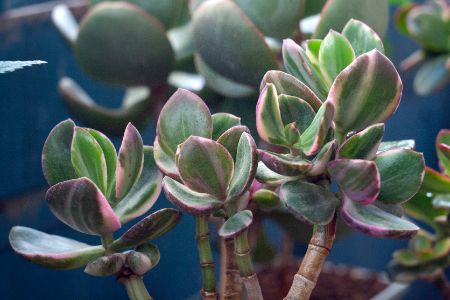
Crassula ovata ‘Gollum’
Named after the eponymous character in J.R.R. Tolkien’s novels, this variety of jade plant has elongated, tubular leaves and an interesting growth habit. The concave ends of the leaves become red in bright light making this an eye catching choice.
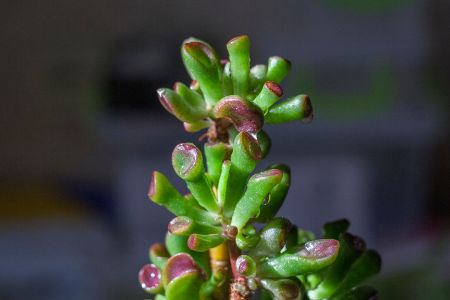
Crassula Ovata ‘Hobbit’
This variety is similar to the Gollum variety, but has curled leaves. It can sometimes be a little tricky to tell these two apart, but as you can see, most of the leaves on the ‘Hobbit’ should look curled back rather than cylindrical.
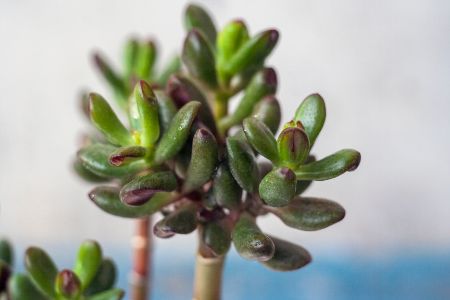
Crassula ovata ‘Blue Bird’
This variety is a hybrid of Crassula ovata and Crassula arborescens and has more curled leaves which have a distinctive blue-grey color. It tends to have a more branched growth habit and is ideal for growing as a bonsai.
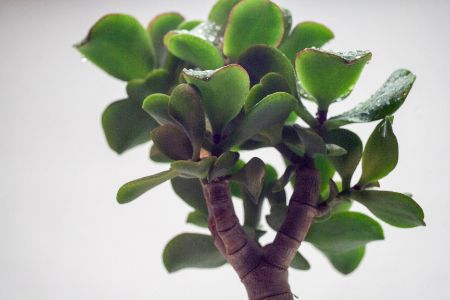
Crassula ovata ‘Hummel’s Ghost’
This variegated cultivar can look quite dramatic with the contrasting red, yellow and green colors of its leaves. Cool, dry and bright conditions will promote the most vibrant colors from this less common variety.
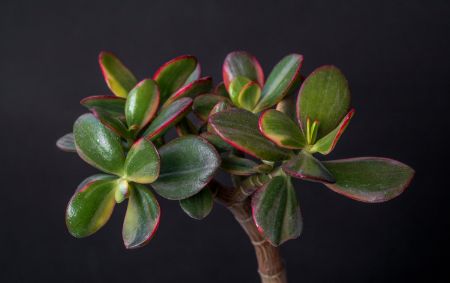
Crassula ovata ‘Crosby’s Compact’
This miniature jade plant cultivar is smaller that a standard jade plant in every way, growing to approx 3 feet (90cm) in height. The smaller leaves have edges that are usually significantly colored, red and yellow.
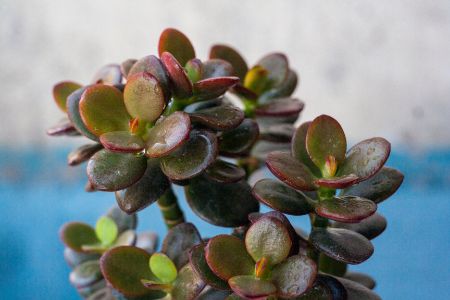
Crassula ovata ‘Minima’
This dwarf jade plant cultivar grows to a maximum size of 2.5 feet or 75cm, with smaller leaves and more compact growth.
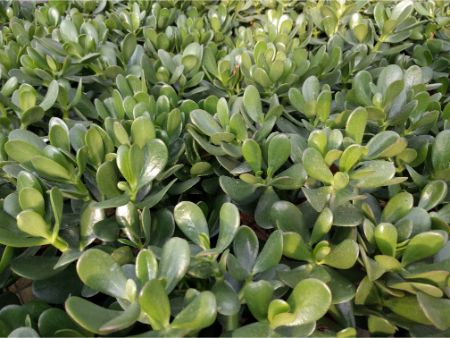
Here is a fascinating website with descriptions and pictures of many of the different jade plant varieties.
Jade Plant Diseases
Disease is usually not a major problem in jade plant care, and those that do affect them are often caused by overwatering or poor growing conditions. If you are having problems, take another look at the jade plant care conditions you are providing and make a few adjustments.
Bacterial Soft Rot
Bacterial Soft Rot is a disease caused by Erwinia, a bacterium. Once the plant contracts bacterial soft rot, it can spread through the plant, causing it to collapse and die. Bacterial soft rot is treated by removing the diseased parts of the plant in order to stop the spread of the infection.
Use clean shears to remove the damaged parts and discard them immediately so they do not infect the plant further. If you have removed all of the infected parts of the plant, it should be able to recover.
Powdery Mildew
Powdery mildew appears as white spots on leaves, and then can spread and cause lesions and waxy scabs. You can prevent powdery mildew by providing plenty of air circulation. Don’t wet the leaves or branches when you water your jade plant and give the soil enough time to dry out in between waterings.
Black Ring Disease
If you see black rings or marks on the underside of your jade plant’s leaves, you may have black ring disease. This is caused by a virus and there is no way to treat the disease. You can remove the affected areas and repot the plant in fresh soil to save the plant, however, do not propagate cuttings from any infected plants. Do not reuse the infected soil.
Jade Plant Pests
Mealybugs are the most common pest to attack jade plants. A heavy infestation can kill the plant. When mealybugs feed on the jade plant, it can cause the leaves to wither. The waste product excreted by mealybugs is called honeydew.
An accumulation of honeydew on the leaves of the plant leads to the growth of sooty mold. You can treat a mealybug infestation by cleaning off white, waxy spots with a cotton swab dipped in rubbing alcohol.
Spider mites can be identified by their white, waxy webs. If untreated, spider mites can cause severe damage to jade plants. Donna Joshi shows the kind of damage that spider mites can do in her YouTube video:
I’ve written an article all about getting rid of spider mites from your plants which you may find useful.
Are Jade Plants Poisonous?
According to calpoison.org, jade plants are not toxic to children. However, sensitive individuals could have a negative reaction if they ingest or touch the plant.
Jade plants are toxic to dogs, cats, and horses, and could cause vomiting and depression. If your child has ingested any jade plants, call your local poison control center. If your pet has ingested any of this plant, call your veterinarian.
Common Jade Plant Care Problems And Questions
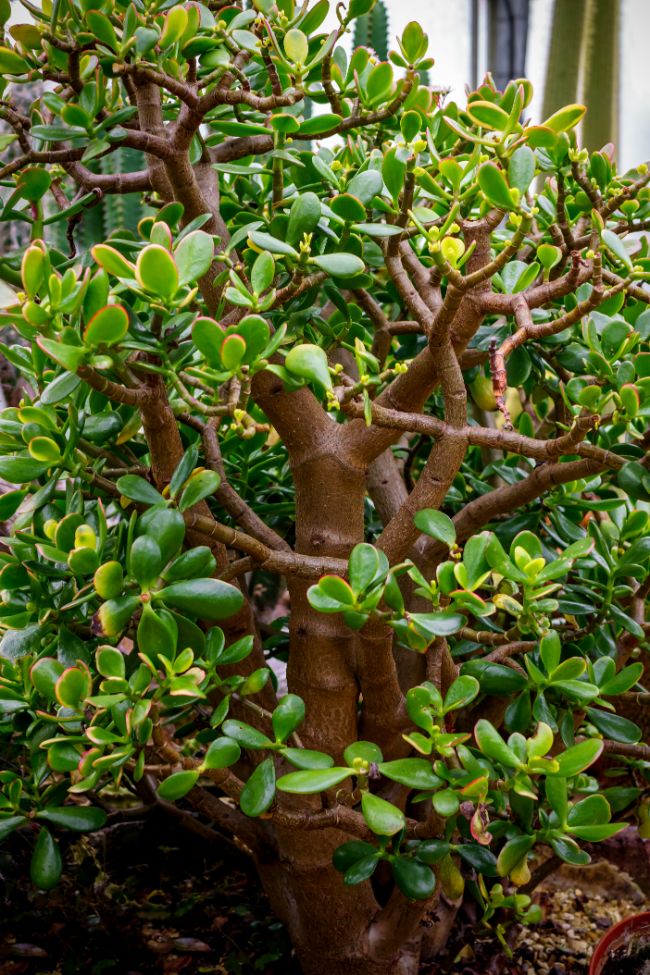
Why Is My Jade Plant Turning Red?
Jade plants, like other succulents, thrive under harsh conditions that could easily kill more delicate plants. Stressors such as harsh sunlight, temperature changes, or lack of water may cause your jade plant to turn red around the tips. As long as your jade plant is otherwise healthy, there is no cause for concern.
I’ve covered this topic in a separate article all about why jade plants turn red, how to prevent it and why it isn’t always a bad thing.
Why Is My Jade Plant Turning Yellow?
The most common cause of yellowing leaves on a jade plant is overwatering. Jade plants do not like ‘wet feet’ – they need their soil to dry out well in between waterings. Jade plants can store water in their leaves. The leaves may visibly plump up after the plant has absorbed enough water.
Read my other article about jade plant care that covers the symptoms of jade plant overwatering and how to prevent and treat it.
Why Is My Jade Plant Turning Black?
If your jade plant starts turning black at the bottom, it has likely been overwatered to the point that it is rotting from the roots. If there are black spots on the leaves of your plant, it could be due to an injury such as a bite from a cat or from high humidity. Black rings on the undersides of leaves indicate black ring disease.
Why Is My Jade Plant Drooping?
The most likely cause of a drooping jade plant is overwatering. In the wintertime, jade plants need much less water to survive because the plant is resting. In the spring and summer, jade plants need more water to support its active growing season. If your jade plant is drooping, make sure you are not overwatering it.
Why Is My Jade Plant Losing Leaves?
Your jade plant could lose leaves for a number of reasons. If you are overwatering your jade plant, they will turn yellow and fall. If you are underwatering your jade plant, the leaves will shrivel and crystallize before they fall. If there are white waxy webs, your jade plant is being attacked by spidermites or even mealybugs. Occasionally, a lack of nitrogen in the soil can cause leaves to fall.
I’ve written another article covering all the reasons why jade plants drop leaves and how you can prevent it or fix the cause.
Why Does My Jade Plant Have Bumps On Its Leaves?
Bumps on the leaves of jade plants, especially on the undersides, are most likely caused by an insect infestation. Sucking insects can attach themselves to plant leaves, looking like tiny bumps. Your best defense against these bumps is to wipe them with a cotton swab dipped in rubbing alcohol.
To prevent insect infestations, spray the leaves down with a mix of dish soap and water. Gently shake off excess water so it doesn’t damage the leaves. You can do this several times per year to prevent insects from attacking your plant.
Why Is My Jade Plant Growing Crooked?
Your jade plant is probably growing crooked due to an uneven light source. If you keep your jade plant in a window, you’ll need to turn it regularly so that the entire plant receives and even amount of sunlight. If it is too late, and your plant is already crooked, you can heavily prune the uneven side. Your plant should recover without difficulty.
If the plant is drooping and leaning to one side, it could be the result of overwatering, underwatering, or an insect infestation that is damaging the plant.
How Can I Tell If My Jade Plant Is Overwatered?
If your jade plant is overwatered, the first sign will be overly wet soil. If you pull the plant out of its pot, the roots may be mushy or show signs of rotting. If the overwatering progresses further, you will begin to see yellowing leaves and soft leaves. Eventually the leaves will fall off.
Why Are My Jade Plant Leaves Crystalizing?
Most jade plant care problems are the result of overwatering. However, if your plant’s leaves are looking withered and beginning to appear to have crystals form on them, you may not be watering your plant enough. This is one of the reasons for getting white spots on jade plants that I cover in this article.
First, check the root system by sliding the plant out of the pot. If the roots are soggy, mushy, or look rotted, the plant is getting too much moisture. However, if the roots are strong and solid, then the problem is most likely your plant is not being watered enough. Increase the frequency of watering and watch for the leaves of your jade plant to become plump again.
How Can I Save My Overwatered Jade Plant?
Signs of overwatering are yellowing leaves, drooping leaves, and dropping leaves. Other signs are mushy roots and stems. If your jade plant has been overwatered, it is still possible to save it.
First, you’ll need to repot your jade plant into fresh, dry soil. Make sure you use a pot with good drainage holes and a potting mixture of about 50% perlite to 50% potting soil (or you can use any commercial cacti and succulent soil). If the stem is too mushy, cut it above the part that is dying and then propagate it as if it was a fresh cutting.
How Can I Trim My Leggy Jade Plant?
If your jade plant is looking leggy, or tall and spindly, you can prune it to encourage it to grow in a more stout, bushy shape. If it is just new growth that is looking spindly, you can pinch the new growth back to where it begins. However, if the branches and stems are also looking spindly, you can give it a good pruning.
Look for a leaf scar on the stem you want to prune. A leaf scar is the brown ring on the stem. Prune the plant at the leaf scar with clean sharp shears. In most cases, there will be two new growths to replace the one that was pruned away. You can take the branches and stems that you pruned away and propagate them to grow new jade plants.

